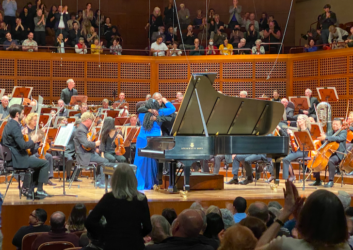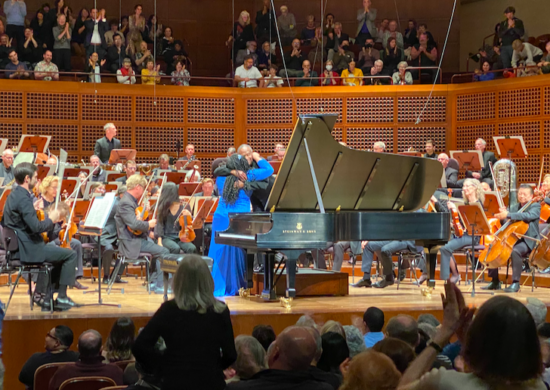 United States Bernstein, Gershwin, Still: Michelle Cann (piano), San Francisco Symphony / Thomas Wilkins (conductor). Davies Symphony Hall, San Francisco, 25.10.2024. (HS)
United States Bernstein, Gershwin, Still: Michelle Cann (piano), San Francisco Symphony / Thomas Wilkins (conductor). Davies Symphony Hall, San Francisco, 25.10.2024. (HS)

Bernstein (arr. Harmon) – Suite from Candide
Gershwin – Rhapsody in Blue; Porgy and Bess – A Symphonic Picture (arr. Bennett)
Still – Wood Notes
In the mid-twentieth century, it was common to refer to the population of the United States as a ‘melting pot’. Immigrant cultures, often segregated or ghettoed in those days, mixed with the established population and made more of a salad or a mixed plate than something melting together. American composers, however, absorbed musical elements from these cultures, not least because they came from them.
Four mid-century works made the point on a lively program of composers who represented that mix of cultures in their music. Assembled by conductor Thomas Wilkins, the concert drew an enthusiastic response from the audience in Davies Symphony Hall. How can you go wrong with a lineup that sandwiched distinguished Black composer William Grant Still between George Gershwin and Leonard Bernstein, both born of Eastern European Jewish immigrants.
Gershwin was twenty-five and the king of Tin Pan Alley and Broadway, absorbing elements of African-American jazz into his music, including the two pieces played here. The centerpiece (and, ironically, the shortest of the four works) was Rhapsody in Blue, which has been heard in almost every classical music venue this year as it approaches its hundredth anniversary. On assignment from big band leader Paul Whiteman, Gershwin fused jazz elements with a classical form in this quasi-piano concerto. Whiteman’s music director, Ferde Grofé (best known in classical circles for his Grand Canyon Suite), orchestrated the piece for the small-orchestra premiere and later adapted it for a full symphony orchestra.
Making her debut with the San Francisco Symphony, pianist Michelle Cann dived into the tricky fingerings, rhythms and virtuosic flair of the solo part, taking a decidedly jazz-oriented approach to turns of phrase and shifting rhythms. Her playing was electric, not always note-perfect but irresistibly creative. On the piano faculties of the Curtis Institute in Philadelphia and the Manhattan School of Music in New York, Cann was an early champion of Florence Price, the prominent Black woman composer and a contemporary of Gershwin’s.
Wilkins brought out jazz elements in the orchestra. He encouraged clarinetist Carey Bell to start things off with a positively filthy opening glissando, and got tight, juicy rhythms throughout the piece. The quick rhythmic gives-and-takes between conductor and pianist stood out for their cohesiveness, and Wilkins and Cann neatly synchronized subtle rubatos and balancing dynamics. There was plenty of muscle and a nice sense of clarity.
Wood Notes, a 1947 suite offering four idyllic tone poems, showcased William Grant Still, the first African-American to gain respect as a symphonic composer. It is not as obviously representative of the culture’s music as his first symphony, the Afro-American (1931), but its leisurely pace and soft-hued folk tunes produced smiles, framed as they were by plush orchestration. The cakewalk overtones of the brief finale, ‘Whippoorwill’s Shoes’, brought things to a snappy close.
At both ends of the program were mashups from mid-century opera house favorites by Gershwin and Bernstein, both of whom reveled in the music of cultures alongside their own. Wilkins set the tone for the evening with a frisky reading of an inspired medley of sections from Candide, Bernstein’s 1956 operetta, in an arrangement by Charlie Harmon, who was Bernstein’s music assistant and music editor of the Bernstein estate. The patchwork collection touched on the composer’s frothy mix of dance hall music, tangos, waltzes and parodies of opera tropes, building a merry bounce through the score. It avoided beginning with the well-known riffs of the overture, saving them for a place in the middle as the ‘Battle Music’ they were in the show’s score.
At the end was more Gershwin: Porgy and Bess – A Symphonic Picture. Robert Russell Bennett, the arranger who orchestrated much of Gershwin’s work, including this beloved opera, constructed a medley of unforgettable tunes and scenes from it at the behest of conductor Fritz Reiner. The Pittsburgh Symphony debuted it in 1942, five years after the composer’s death.
The piece may have overstayed its welcome by including too many highlights from the opera (at twenty-four minutes it was the longest on the program), but it brought out a range of evocative underlying orchestral music. I especially liked the all-orchestral arrangement of the Catfish Row scene-setter, various instruments replacing the vendors’ vocals, and the adapted songs sung in the opera by Sportin’ Life (especially ‘I Got Plenty of Nuttin’). The dazzling xylophone and brass opening of the overture popped up in the middle as a sort of centerpiece, and led into the finale, ‘Oh Lawd, I’m on My Way’.
Harvey Steiman

I’m happy the ‘Symphonic Picture’ was played at full length. Nowadays conductors sometimes lop off the lovely first 5-6 minutes of scene-setting—and without even telling their audience. Fritz Reiner (who’d promoted GG and his music even in the 1920s) really was the medley’s architect, specifying the excerpts/sequence practically down to the bar; he stipulated a couple transpositions from the original to avoid any rough key-successions. The 24-minute length? Chosen to fit just-right onto three 78rpm record discs of the time.